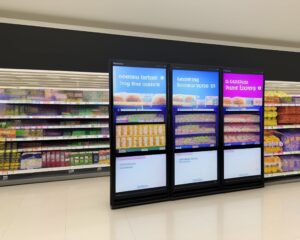Audience segmentation is a crucial aspect of retail media networks, as it allows retailers to tailor their marketing and advertising efforts to specific groups of consumers. By dividing their audience into smaller segments based on various characteristics, retailers can create more targeted and effective campaigns that are more likely to resonate with their desired audience. Audience segmentation in Retail Media networks is becoming vital to increase revenue and sales.
This article will explore the various types of audience segmentation that are commonly used in retail media networks. Furthermore, the benefits of implementing this strategy, and some real-world examples of successful audience segmentation in action. It will also explore some of the challenges that retailers may face and how they can overcome them.
Types of audience segmentation in retail media networks
There are several different ways that retailers can segment their audience, each of which can be effective in certain situations. Some of the most common types of audience segmentation in retail media networks include:
Demographic segmentation in Retail Media
This type of segmentation divides the audience based on characteristics such as age, gender, income, education level, and occupation. For example, a clothing retailer might create separate campaigns for men and women, or for different age groups.

Psychographic segmentation in Retail Media
Behavioral segmentation in Retail Media
This type of segmentation divides the audience based on their past actions, such as their purchasing history or their interactions with the brand. For example, a retailer might create separate campaigns for loyal customers and those who are new to the brand.
Geographical segmentation in Retail Media
This type of segmentation divides the audience based on their location, such as by country, region, or city. For example, a clothing retailer might create separate campaigns for customers in different parts of the world or in different climate zones.

Benefits of audience segmentation in retail media networks
There are several benefits to using audience segmentation in retail media networks, including:
- Targeted marketing and advertising. By segmenting the audience, retailers can create campaigns that are more relevant and appealing to specific groups of consumers. This can lead to higher engagement and conversion rates, as well as a more positive brand image.
- Increased customer loyalty and retention. By understanding the needs and preferences of different segments of the audience, retailers can create a more personalized and enjoyable shopping experience. This can lead to increased customer loyalty and higher retention rates.
- Improved ROI on marketing efforts. By targeting their campaigns more effectively, retailers can potentially reduce their marketing costs and increase their return on investment.
Case studies of successful audience segmentation in retail media networks
There are many examples of retailers using audience segmentation to create successful marketing campaigns. Here are a couple of examples:
Example 1: A clothing retailer targeting different demographics through social media ads
A clothing retailer wanted to increase sales of its latest collection, which featured a mix of casual and formal clothing. To reach the right audience, the retailer segmented its social media followers based on their age, gender, and interests. For younger, trendier customers, the retailer created ads featuring models wearing casual clothing and highlighted the brand’s sustainability efforts. For older, more traditional customers, the retailer created ads featuring models wearing formal clothing and emphasized the brand’s reputation for quality and style.
As a result of this targeted approach, the retailer saw a significant increase in sales of both casual and formal clothing. The younger audience responded well to the emphasis on sustainability, while the older audience appreciated the focus on quality and style.

Example 2: A grocery store using location-based segmentation to send personalized coupons to customers
A grocery store wanted to increase customer loyalty and sales of its private-label products. To do this, the store used location-based segmentation to send personalized coupons to customers based on their shopping history and location. For example, customers who frequently purchased meat and vegetables at the store received coupons for the store’s private-label meat and vegetables, while customers who frequently purchased dairy products received coupons for the store’s private-label dairy products. The store also used location-based segmentation to send coupons for items that were popular in the customers’ area, such as locally grown produce.

As a result of this targeted approach, the grocery store saw an increase in sales of its private-label products and a higher rate of customer loyalty. Customers appreciated the personalized coupons and the convenience of receiving offers for products they were likely to purchase.
Challenges of implementing audience segmentation in retail media networks
While audience segmentation can be a powerful tool for retailers, it is not without its challenges. Some of the key challenges that retailers may face when implementing audience segmentation include:
- Data privacy concerns. Retailers must be mindful of data privacy laws and regulations when collecting and using customer data for segmentation purposes. This includes obtaining consent from customers and being transparent about how their data will be used.
- Limited resources and time for segmentation efforts. Segmenting the audience can be a time-consuming process. Moreover, it may require additional resources such as data analysts or marketing specialists. Retailers must be prepared to allocate the necessary resources and time to ensure the success of their segmentation efforts.
- Potential for segmentation to exclude certain groups. While audience segmentation can be effective in targeting specific groups of consumers, it can also potentially exclude other groups. Retailers must be mindful of this risk and ensure their marketing efforts are inclusive of their entire audience.
The Role of In-Store Tracking Technology for Audience Segmentation Offline
In-store tracking technology can play a significant role in helping retailers to segment their audience offline. These technologies can gather data on customer behavior and preferences, such as what products they purchase, how long they spend in the store, and what areas of the store they visit. This data can be used to create targeted marketing campaigns and personalized offers for customers, similar to how online audience segmentation is used.
For example, a retailer could use in-store tracking technology to send personalized offers to customers based on their past purchases. A customer who frequently purchases beauty products might receive an offer for a new skincare line. On a separate note, a customer who frequently purchases electronics might receive an offer for a new smart home device. This targeted approach can help retailers to increase sales and customer loyalty.

In addition to targeting marketing efforts, in-store tracking technology helps retailers to optimize their store layout based on customer behavior. By analyzing how customers move through the store and their product interactions, retailers can make product-placement decisions. Ultimately, determine how to design their store layout to improve the shopping experience.
However, it is important for retailers to be transparent about their use of in-store tracking technology. As mentioned when exploring the challenges, retailers must ensure they are respecting customer privacy. Retailers should clearly communicate how they are using this technology. Provide customers with the option to opt out if they prefer. Be transparent and respectful of customer privacy.
Conclusion
In conclusion, audience segmentation is a valuable strategy for retailers looking to increase the effectiveness of their marketing and advertising efforts in retail media networks. By dividing their audience into smaller segments based on various characteristics, retailers can create targeted campaigns that are more likely to resonate with their desired audience. Some of the key benefits of audience segmentation include targeted marketing and advertising, increased customer loyalty and retention, and improved ROI on marketing efforts.
However, retailers must also be mindful of the challenges that can arise when implementing this strategy, such as data privacy concerns, limited resources and time for segmentation efforts, and the potential for segmentation to exclude certain groups. By carefully considering these challenges and implementing audience segmentation in an ethical and transparent manner, retailers can effectively use this strategy to improve their overall marketing success.
Shoppermotion provides in-store tracking solutions to help retailers improve their audience segmentation efforts. Shoppermotion’s Retail Media Solutions gather data on customer behavior and preferences in the physical store. This data can be used to create targeted marketing campaigns and personalized offers for customers, as well as to optimize the store layout and inventory based on customer behavior. By using Shoppermotion’s solutions, retailers can effectively segment their audience and improve their overall marketing success.






